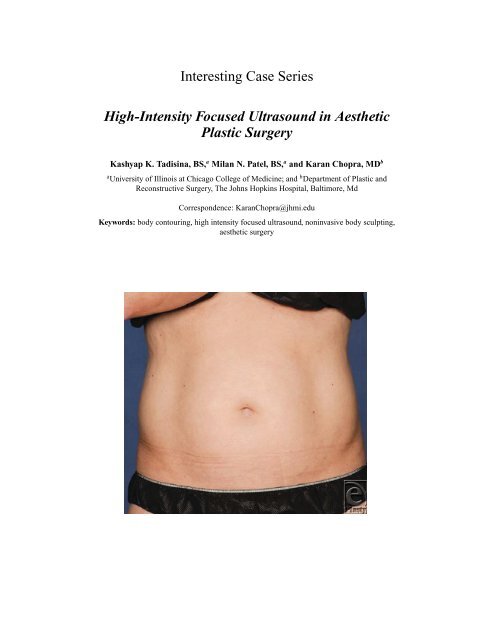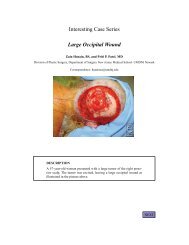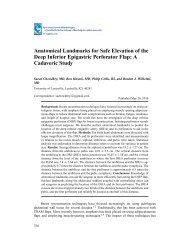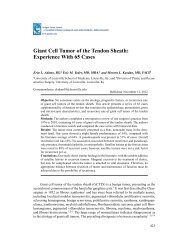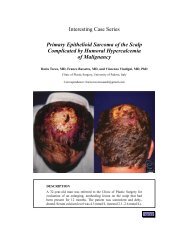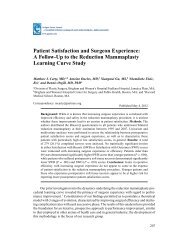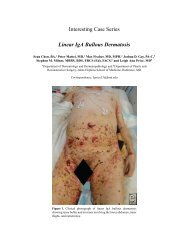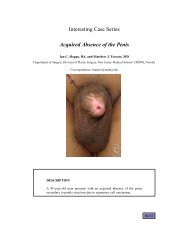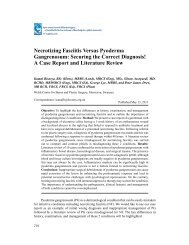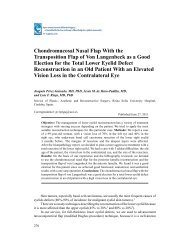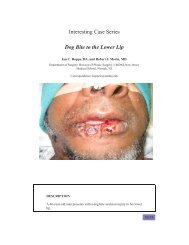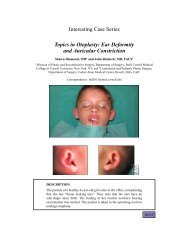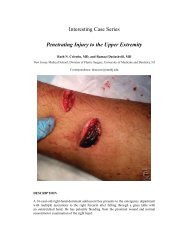Interesting Case Series High-Intensity Focused Ultrasound ... - ePlasty
Interesting Case Series High-Intensity Focused Ultrasound ... - ePlasty
Interesting Case Series High-Intensity Focused Ultrasound ... - ePlasty
You also want an ePaper? Increase the reach of your titles
YUMPU automatically turns print PDFs into web optimized ePapers that Google loves.
<strong>Interesting</strong> <strong>Case</strong> <strong>Series</strong><br />
<strong>High</strong>-<strong>Intensity</strong> <strong>Focused</strong> <strong>Ultrasound</strong> in Aesthetic<br />
Plastic Surgery<br />
Kashyap K. Tadisina, BS, a Milan N. Patel, BS, a and Karan Chopra, MD b<br />
a University of Illinois at Chicago College of Medicine; and b Department of Plastic and<br />
Reconstructive Surgery, The Johns Hopkins Hospital, Baltimore, Md<br />
Correspondence: KaranChopra@jhmi.edu<br />
Keywords: body contouring, high intensity focused ultrasound, noninvasive body sculpting,<br />
aesthetic surgery
DESCRIPTION<br />
A 34-year-old healthy man presents requesting abdominal liposuction for excess abdominal<br />
fat. The patient had a strong preference for minimally invasive techniques. Therefore, <strong>High</strong>intensity<br />
focused ultrasound (HIFU) therapy was performed.
QUESTIONS<br />
1. What is HIFU and how does it work?<br />
2. What is HIFU currently used for?<br />
3. What are some of the recognized shortcomings and complications of<br />
HIFU?<br />
4. What is the future of HIFU?
DISCUSSION<br />
<strong>High</strong>-intensity focused ultrasound is the result of the evolution of ultrasound from a simple<br />
diagnostic procedure to a therapeutic modality with broader potential. <strong>Ultrasound</strong> has long<br />
been an intriguing medical modality because of its noninvasive nature, low cost, and relatively<br />
low rate of complications. 1 Sound is transmitted by mechanical vibrations; ultrasound<br />
technology utilizes vibrations that are outside of the range of human hearing. <strong>High</strong>-intensity<br />
focused ultrasound, in comparison to typical ultrasound, uses lower frequencies and higher<br />
energy levels by several orders of magnitude. 1 As compared to normal ultrasound, where<br />
acoustic waves are resorbed and deflected through tissue, HIFU can target a specific volume<br />
(on the order of millimeters) within the body cavity without harming surrounding tissues. 2<br />
A major advantage is that the energy is nonionizing and can theoretically be repeated an<br />
unlimited number of times. <strong>High</strong>-intensity focused ultrasound works via 2 major underlying<br />
mechanisms, the first of which is hyperthermia. Concentrated energy causes temperatures<br />
to exceed the upper limit of protein denaturation (43 ◦ C), and can reach as high as 80 ◦ C,<br />
causing instant coagulative necrosis of targeted cells without damage to surrounding areas. 3<br />
The second major mechanism is cavitation formation. At higher energy levels, alternating<br />
compression and expansion of sound waves create gas cavities that implode and subsequently<br />
cause mechanical damage to the target tissues (eg, adipose) through the release of<br />
high levels of pressure and heat in the microenvironment. 2 This mechanism, although more<br />
powerful, tends to be more unpredictable and harder to control, and thus its use is limited<br />
compared to hyperthermia.<br />
<strong>High</strong>-intensity focused ultrasound is most widely recognized in the treatment of benign<br />
and malignant solid tumors. 4 It has been successfully used to treat tumors of the liver,<br />
kidneys, pancreas, breast, prostate, and even bone. 4 Most recently, HIFU has been implemented<br />
in the outpatient setting as a technology used for cosmetic procedures. Although<br />
radiologic techniques have been used as an adjunct to traditional liposuction in the past,<br />
this is the first ultrasound technique used as the primary form of adipocyte reduction. 5<br />
<strong>High</strong>-intensity focused ultrasound has been used effectively for noninvasive body sculpting<br />
to either tighten skin by contracting collagen fibers or remove adipose tissue stores via<br />
ablation. 6 Previous studies have demonstrated that optimal results are obtained when the<br />
patients have a BMI less than 30 kg/m 2 and have at least 1 cm of adipose tissue beyond the<br />
treatment area. 7,8 Average treatment times are reported at 45 to 60 minutes with minimal to<br />
no recovery time. Patient satisfaction rates have been reported as high as 70% at 3 months<br />
follow-up. 9 Fatemi et al have shown that within 18 weeks of HIFU-mediated adipose tissue<br />
ablation, 95% of the cellular debris had been reabsorbed, without posttreatment changes in<br />
patients’ lipid profiles or comprehensive metabolic panels. 8,9 It has also been employed as<br />
an adjunct to craniofacial surgical procedures, namely to minimize postrhinoplasty nasal<br />
tip edema. 10 Utilizing thermal coagulation to cause contraction of collagen fibers, skin<br />
was “drawn taught” over underlying collagenous architecture. Concurrently, small amounts<br />
of adipose tissue can be removed, making this a useful treatment option in patients who<br />
have not had success with other treatment modalities due to either their skin or anatomical<br />
contours. 11<br />
Traditional shortcomings of HIFU include those of diagnostic ultrasound, most importantly<br />
that sound waves cannot pass through solid structures (ie, bone) and are impeded<br />
by air, limiting its use in hollow organs such as the lungs. 4 Furthermore, anesthesia is
equired for longer and more complicated anatomical procedures, particularly in enlarged<br />
tumor ablation. When utilizing ultrasound, it is vital to know patients’ individual anatomy,<br />
as a proper “acoustic” window must be available in order for sound waves to reach their<br />
desired location. If solid objects such as organs, prostheses, or bones lie in between the<br />
target and transducer, other modalities must be considered as HIFU’s efficacy is dramatically<br />
reduced. 1 In the setting of noninvasive body sculpting, patients have reported feeling<br />
localized tingling/prickling sensations along with mild warmth and pain during treatment.<br />
Commonly reported posttreatment adverse effects include discomfort, ecchymosis, paresthesias,<br />
and edema. All of these are temporary and mild in intensity, with the vast majority<br />
resolving within 12 weeks. 6,12<br />
<strong>High</strong>-intensity focused ultrasound has only recently made its debut in the plastic<br />
surgery community, with preliminary studies being promising and exciting. It has been<br />
shown to be safe at much higher doses and duration than are typically necessary in the<br />
outpatient setting 6 with initial studies showing high patient satisfaction and reproducible<br />
results, 3 making it an option for plastic surgeons to consider when encountering patients<br />
requesting body contouring or liposuction, particularly those who are poor candidates for or<br />
resistant to surgery. Research is also being conducted evaluating the utilization in nontraditional<br />
settings such as thrombolysis, vascular hemostasis, drug/gene therapy, 4 and targeted<br />
tumor cell chemotherapy. 13 Advancements in the intraoperative assessment of temperature<br />
with magnetic resonance imaging, 2 localization with 3-dimensional ultrasound, 2 and<br />
quantification of collagen contraction with elastography 1 combined with the expected advancements<br />
in ultrasound technology pave the way for HIFU to potentially revolutionize the<br />
future of noninvasive plastic surgery. As medicine moves toward less invasive modalities,<br />
such as interventional radiology and laparoscopic and robotic procedures, HIFU is poised<br />
to meet the demand of many clinical scenarios including solid tumor treatment, vascular<br />
injury, drug delivery, and both aesthetic and reconstructive procedures.<br />
REFERENCES<br />
1. Kennedy JE. <strong>High</strong>-intensity focused ultrasound in the treatment of solid tumors. Nat Rev Cancer.<br />
2005;5(4):321-7.<br />
2. Zhou Y-F. <strong>High</strong> intensity focused ultrasound in clinical tumor ablation. World J Clin Oncol. 2011;2:8-27.<br />
3. Shalom A, Wiser I, Brawer S, Azhari H. Safety and tolerability of a focused ultrasound device for<br />
treatment of adipose tissue in subjects undergoing abdominoplasty: a placebo-control pilot study.<br />
Dermatol Surg. 2013;39(5):744-51.<br />
4. Cordeiro ER, Cathelineau X, Thüroff S, Marberger M, Crouzet S, de la Rosette JJ. <strong>High</strong>-intensity<br />
focused ultrasound (HIFU) for definitive treatment of prostate cancer. BJU Int. 2012;110(9):1228-42.<br />
5. Paul M, Mulholland RS. A new approach for adipose tissue treatment and body contouring using<br />
radiofrequency-assisted liposuction. Aesthetic Plast Surg. 2009;33(5):687-94.<br />
6. Jewell ML, Solish NJ, Desilets CS. Noninvasive body sculpting technologies with an emphasis on<br />
high-intensity focused ultrasound [Review]. Aesthetic Plast Surg. 2011;35(5):901-12.<br />
7. Stephan PJ, Kenkel JM. Updates and advances in liposuction. Aesthetic Surg J. 2010;30:83-97.<br />
8. The American Academy of Cosmetic Surgery. 2006 Guidelines for Liposuction Surgery. Available at:<br />
http://www.cosmeticsurgery.org/media/2006 liposuction guidelines.pdf. Accessed March 26, 2010.<br />
9. Fatemi A. <strong>High</strong>-intensity focused ultrasound effectively reduces adipose tissue. Semin Cutan Med Surg.<br />
2009;28(4):257-62.
10. Ferraro GA, De Francesco F, Nicoletti G, Rossano F, D’Andrea F. Histologic effects of external<br />
ultrasound-assisted lipectomy on adipose tissue. Aesthetic Plast Surg. 2008;32(1):111-5.<br />
11. Kornstein AN. Ultherapy shrinks nasal skin after rhinoplasty following failure of conservative measures.<br />
Plast Reconstr Surg. 2013;131(4):664e-6e.<br />
12. Sattler G. Body sculpting techniques: noninvasive high-intensity-focused ultrasound innovation in fat<br />
removal. J Clin Dermatol. Available at: http://www.liposonix.com/sites/default/files/Body Sculpting<br />
Techniques Noninvasive <strong>High</strong>-<strong>Intensity</strong>-<strong>Focused</strong> <strong>Ultrasound</strong> Innovation in Fat Removal Sattler<br />
122010.pdf. Accessed July 6, 2013.<br />
13. Park SM, Kim MS, Park SJ, et al. Novel temperature-triggered liposome with high stability: formulation,<br />
in vitro evaluation, and in vivo study combined with high-intensity focused ultrasound (HIFU) [published<br />
online ahead of print June 12, 2013]. J Control Release. doi: 10.1016/j.jconrel.2013.06.003.<br />
Tadisina et al. <strong>High</strong>-<strong>Intensity</strong> <strong>Focused</strong> <strong>Ultrasound</strong> in Aesthetic Plastic Surgery. www.<strong>ePlasty</strong>.com, <strong>Interesting</strong> <strong>Case</strong>,<br />
August 8, 2013


